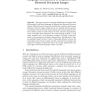Free Online Productivity Tools
i2Speak
i2Symbol
i2OCR
iTex2Img
iWeb2Print
iWeb2Shot
i2Type
iPdf2Split
iPdf2Merge
i2Bopomofo
i2Arabic
i2Style
i2Image
i2PDF
iLatex2Rtf
Sci2ools
83
Voted
DAS
2006
Springer
2006
Springer
Language Identification in Degraded and Distorted Document Images
This paper presents a language identification technique that differentiates Latin-based languages in degraded and distorted document images. Different from the reported methods that transform word images through a character shape coding process, our method directly captures word shapes with the local extremum points and the horizontal intersection numbers, which are both tolerant of noise, character segmentation errors, and slight skew distortions. For each language studied, a word shape template and a word frequency template are firstly constructed based on the proposed word shape coding scheme. Identification is then accomplished based on Bray Curtis or Hamming distance between the word shape code of query images and the constructed word shape and frequency templates. Experiments show the average identification rate upon eight Latin-based languages reaches over 99%. . . .
Related Content
| Added | 22 Aug 2010 |
| Updated | 22 Aug 2010 |
| Type | Conference |
| Year | 2006 |
| Where | DAS |
| Authors | Shijian Lu, Chew Lim Tan, Weihua Huang |
Comments (0)

